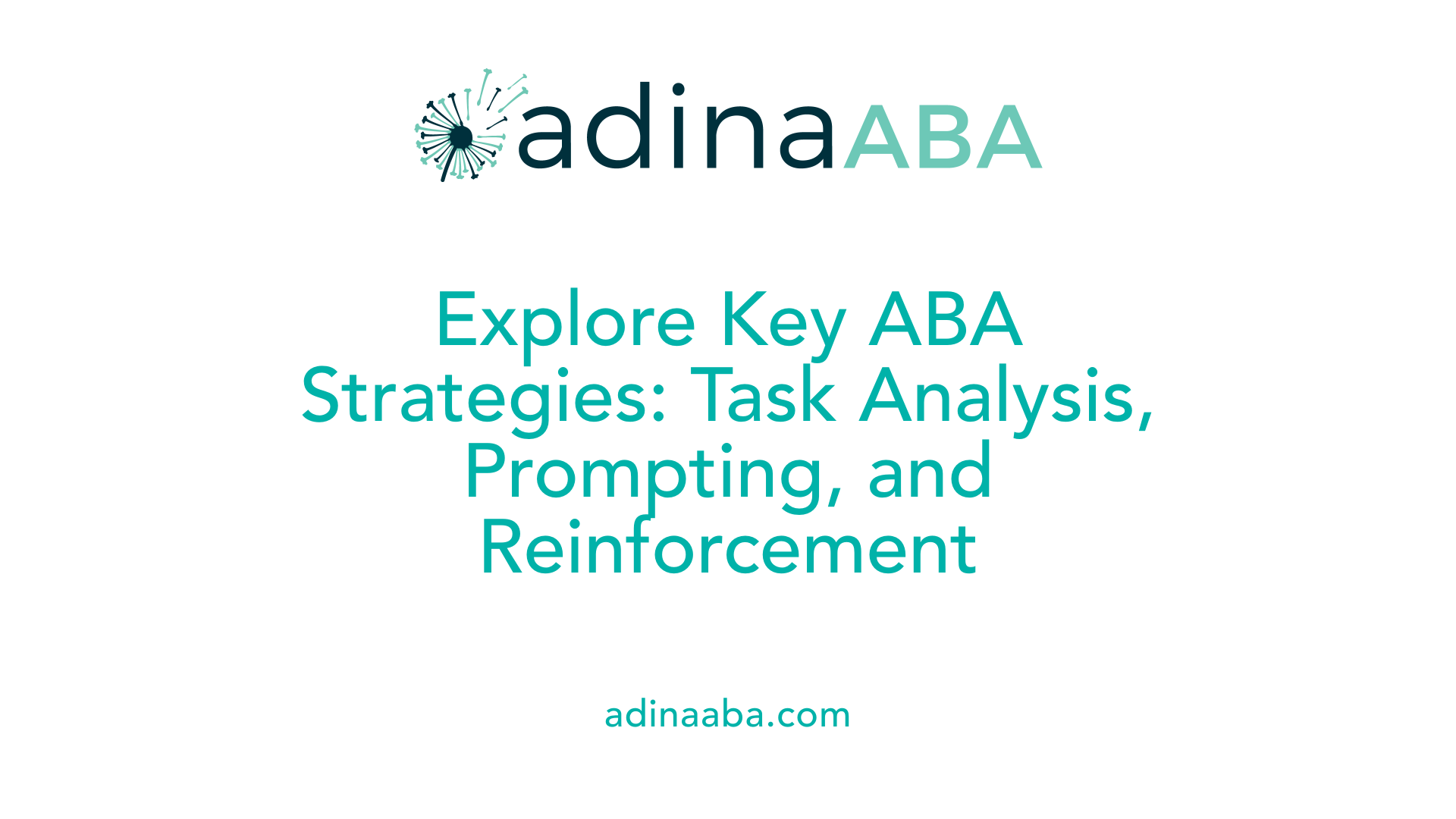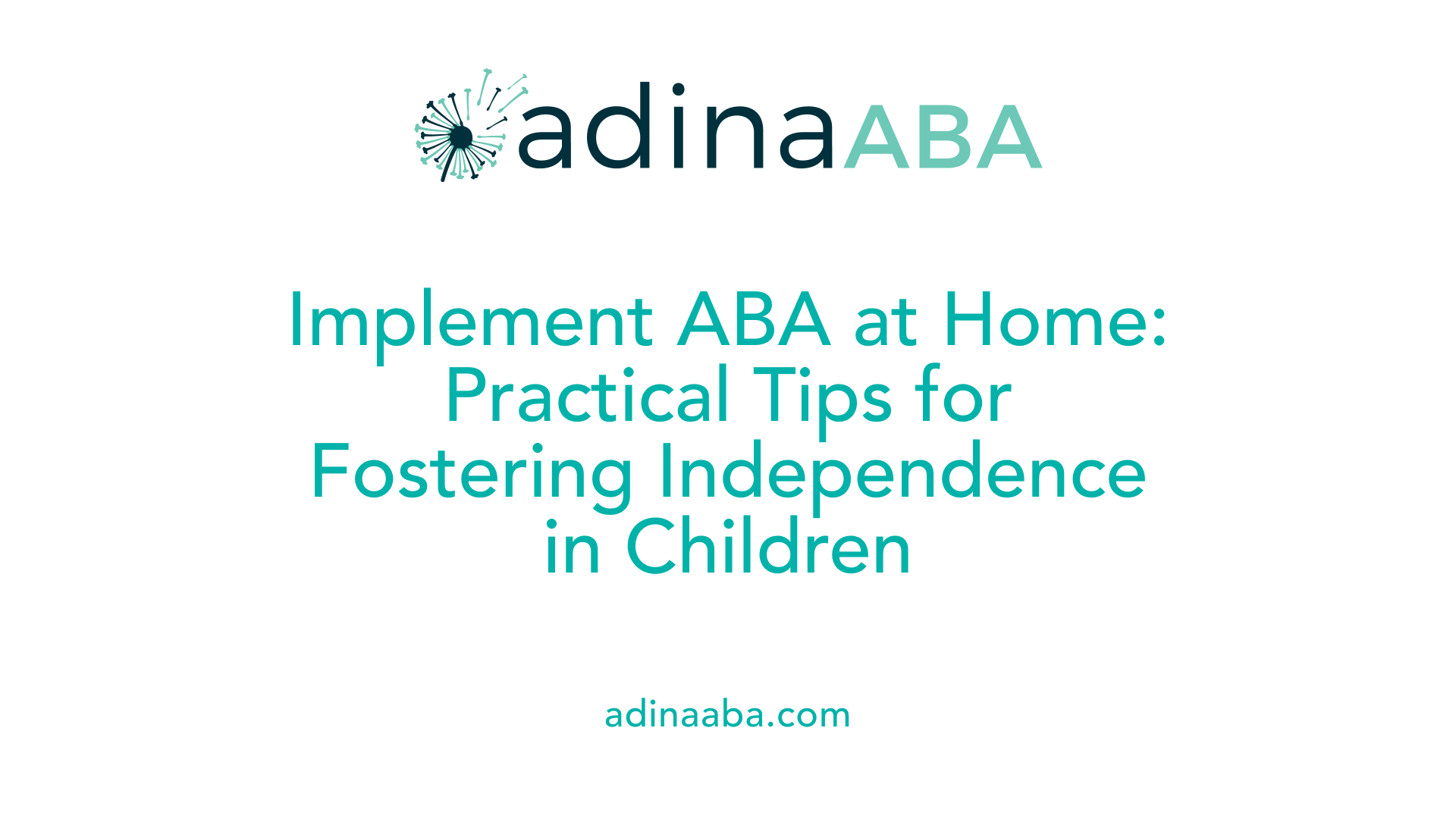How ABA Therapy Helps Children with Autism Build Self-Sufficiency in Daily Activities

Introduction to ABA and Its Role in Building Self-Sufficiency
Applied Behavior Analysis (ABA) is a scientifically supported, individualized approach that helps children with autism develop skills necessary for greater independence. Grounded in principles of learning theory and operant conditioning, ABA focuses on teaching new behaviors and reducing challenges through structured interventions. Its data-driven methodology allows for tailored strategies that adapt to each child's unique needs, fostering growth in communication, daily living skills, and social interactions. This article explores how ABA therapy systematically promotes self-sufficiency in children with autism, highlighting evidence-based practices, methods, and practical implementation at home.
Understanding ABA Therapy and Its Foundations

What principles does ABA therapy rely on, such as operant conditioning and reward-based learning?
ABA therapy is founded on the principles of learning theory, particularly operant conditioning. This means behavior is influenced by its consequences. When a behavior is reinforced with a reward—whether it's praise, a toy, or extra playtime—it is more likely to be repeated. Conversely, behaviors that are ignored or gently discouraged tend to decrease over time. The use of positive reinforcement is central, with strategies tailored to individual preferences to encourage desired behaviors. ABA breaks down complex skills into small, manageable steps, often using techniques like prompting and shaping to guide learning.
This reward-based approach helps individuals with autism recognize the connection between their actions and positive outcomes, fostering motivation to acquire new skills and reduce challenging behaviors.
How did ABA develop historically, and what scientific backing supports its use?
ABA originated in the 1970s from the work of Ole Ivar Lovaas, who developed it as a systematic method for improving social interactions among children with autism. Over the decades, it has evolved through rigorous research and empirical validation. Extensive scientific studies, including meta-analyses and systematic reviews, have consistently shown that ABA can lead to measurable improvements across multiple areas such as communication, social skills, and daily functioning.
Major health organizations, including the American Psychological Association and the U.S. Centers for Disease Control and Prevention, endorse ABA as an evidence-based treatment. While the research supports its effectiveness, especially in young children, it remains a continuously evaluated field, with ongoing studies examining long-term outcomes and optimizing intervention techniques.
What are the core dimensions that guide personalized ABA programs?
The practice of ABA is guided by several core dimensions, often remembered by the mnemonic: Applied, Behavioral, Analytic, Technological, Conceptually Systematic, Effective, and Generality.
| Dimension | Description | Example |
|---|---|---|
| Applied | Focuses on social significance; aims for meaningful changes | Teaching communication skills to enhance social interactions |
| Behavioral | Emphasizes observable behavior changes | Reducing tantrums or increasing speech |
| Analytic | Demonstrates that interventions cause changes | Using data to show when behaviors improve due to specific strategies |
| Technological | Procedures are well-documented and replicable | Clear step-by-step intervention protocols |
| Conceptually Systematic | Interventions are based on ABA principles | Reinforcement schedules based on operant conditioning |
| Effective | Focuses on producing positive, measurable outcomes | Improved adaptive skills and social behavior |
| Generality | Skills learned are applied across environments | Using classroom skills at home or in the community |
These dimensions ensure that each ABA program is tailored, scientifically grounded, and capable of promoting lasting changes.
How does ABA prioritize skill development in communication, social interaction, and independence?
ABA helps individuals with autism develop a broad range of skills, including communication, social interaction, self-care, academic abilities, and emotional regulation. It employs structured teaching methods like discrete trial training, natural environment teaching, and verbal behavior strategies to enhance vocabulary, sentence structure, and pragmatic language skills.
Social skills such as turn-taking, initiation of conversations, sharing, and understanding nonverbal cues are reinforced through play and social activities. For independence, ABA breaks tasks into small steps—like dressing or meal prep—and uses positive reinforcement to build confidence and self-sufficiency.
Furthermore, ABA emphasizes the importance of routines to provide predictability and reduce anxiety, supporting better engagement and progress monitoring. Practicing skills across different settings ensures that children can generalize learned behaviors into real-life situations, ultimately improving their independence and quality of life.
What evidence supports ABA’s effectiveness in building self-sufficiency?
There is substantial scientific evidence supporting the effectiveness of ABA therapy in promoting self-sufficiency in children with autism. Meta-analyses of multiple randomized controlled trials have found that ABA significantly improves social, communicative, and daily living skills, which are key components of independence.
Studies have demonstrated that ABA interventions can lead to meaningful gains in adaptive behaviors, socialization, and expressive language, especially when implemented early and tailored to individual needs. Although evidence for effects on core autism symptoms is limited, the overall data suggest that ABA helps children acquire functional skills necessary for greater independence.
The quality of evidence is generally moderate, but consistent findings across numerous studies affirm ABA as an evidence-based approach for building self-sufficiency in children with autism.
How does ABA therapy enhance daily living skills, and what are its outcomes?
ABA therapy provides targeted interventions that improve critical daily living skills such as self-care, dressing, toileting, and household tasks. These improvements foster greater independence, allowing children to participate more fully in daily life.
By focusing on communication and language development, ABA helps children understand and use words, interpret social cues, and build relationships. It also reduces problematic behaviors, which contributes to better emotional regulation.
A notable benefit is the generalization of skills across various natural environments—home, school, community settings—through consistent practice. This enhances confidence and promotes long-term success.
Research indicates positive outcomes include increased self-esteem and reduced caregiver stress by enabling children to perform daily activities with less assistance. Overall, ABA supports children in achieving meaningful, functional independence that benefits their overall well-being.
Methodologies and Strategies in ABA for Promoting Independence

How does ABA therapy promote independence in children with autism?
ABA therapy employs a variety of targeted strategies to foster independence among children with autism. Central to these approaches is task analysis, which breaks down complex skills—like personal hygiene or household chores—into smaller, manageable steps. This structured method makes learning more accessible and less overwhelming.
Prompting techniques are also vital. These include verbal cues, visual aids such as picture cards, and physical guidance, all supporting the child through the learning process. Importantly, prompts are gradually reduced—known as prompting fading—to encourage the child to perform skills independently.
Positive reinforcement plays a crucial role. Using rewards like verbal praise, stickers, or tokens, therapists motivate children to practice and master new skills. Reinforcement is tailored to each child's preferences, which increases motivation and speeds up skill acquisition.
Visual supports are extensively used to enhance understanding and reduce anxiety. These can include daily schedules, cue cards, or social stories, helping children follow routines and understand expectations across different environments.
Beyond these core techniques, additional methods like video modeling, where children observe peers or adults demonstrating desired behaviors, and self-monitoring tools, enable children to assess their own progress and maintain motivation. Structured work systems help organize learning sessions efficiently.
How does ABA therapy help children with autism develop self-sufficiency in daily activities?
ABA therapy promotes self-sufficiency by systematically teaching everyday skills in a way that fits each child's learning style. Task analysis remains fundamental, ensuring that skills such as dressing, grooming, and preparing simple meals are taught step-by-step. This approach makes challenging activities more manageable.
To encourage independence, therapists employ prompting strategies—visual cues or physical assistance—to support skill development. As children become more confident, prompts are gradually faded out, fostering greater autonomy.
Reinforcement continues to be essential, with rewards provided when children successfully complete steps or entire tasks. This positive feedback reinforces the desire to perform these skills independently.
Generalization of skills across various settings—home, school, community—is a priority. Children are encouraged to practice learned routines in different environments to ensure adaptability. Parent involvement and consistent reinforcement strategies help solidify these skills over time, supporting long-term independence.
Overall, ABA therapy’s structured, individualized interventions, combined with reinforcement and prompting techniques, enable children with autism to develop vital daily living skills and become more self-sufficient in their everyday routines.
The Process of Teaching Skills and Fostering Generalization
How does ABA therapy help children with autism develop self-sufficiency in daily activities?
ABA therapy promotes independence in daily routines by using a structured approach called task analysis. This method breaks down complex skills—like dressing, grooming, or preparing meals—into small, manageable steps. Therapists then teach each step with repeated practice, which helps children learn gradually and confidently.
Positive reinforcement plays a vital role. Rewards such as verbal praise, stickers, or playtime motivate children to perform tasks independently. As skills improve, prompts—like visual cues or physical guidance—are gradually reduced or faded out. This process encourages children to perform skills without constant prompts, fostering true independence.
Ensuring skills carry over into various settings is crucial. ABA therapy emphasizes practicing skills not just at therapy sessions but also at home, school, and community environments. Family involvement and consistent reinforcement help cement these routines.
Over time, ongoing practice and support help children maintain and expand their skills. As they become more self-sufficient, children gain confidence, which further motivates them to take on new challenges in daily living.
What impact does ABA therapy have on improving functional and daily life skills in children with autism?
Research confirms that ABA therapy effectively enhances daily life and functional skills for children with autism. It teaches communication strategies, social interaction, and independence in basic routines. Customized programs utilize reinforcement, prompting, and breakdown of skills through task analysis, making learning accessible and engaging.
These tailored interventions lead to meaningful gains across multiple developmental areas, including language, cognition, and adaptive behaviors such as toileting, dressing, and meal preparation. Such improvements help children participate more fully in home, school, and community life.
Data-driven goal setting ensures that skills are learned and practiced across different environments, promoting generalization. This consistency reduces caregiver stress, enhances family life, and improves overall quality of life.
Long-term engagement with ABA can foster substantial behavioral improvements, providing children with tools to navigate daily routines more independently. Consequently, children develop increased confidence, social skills, and autonomy, which supports their overall integration and well-being.
Implementing ABA at Home to Foster Independence

How can ABA therapy be practically implemented at home to foster independence in children with autism?
Applying ABA therapy in a home setting involves creating a structured, organized environment that minimizes distractions and supports learning. Parents and caregivers play a vital role in this process, working in collaboration with trained ABA therapists to develop personalized strategies tailored to the child's needs.
One of the foundational steps is establishing consistent routines. Routines provide stability, reduce anxiety, and facilitate skill development. For example, breaking down daily activities like dressing, grooming, or mealtime into small, manageable steps—a process known as task analysis—helps children master each component gradually.
Using visual supports such as picture schedules, social stories, and step-by-step charts can significantly enhance understanding and independence. These visual tools serve as prompts and reminders, guiding children through tasks and expected behaviors. Prompts, whether verbal, gestural, or physical, are used initially to facilitate learning and are gradually faded as the child gains confidence and proficiency.
Positive reinforcement, tailored to what motivates the child—such as praise, stickers, or small rewards—is crucial for encouraging desired behaviors. Consistent application of reinforcement strategies helps increase the likelihood of independent task completion.
Parental involvement is essential for success. Parents should work closely with ABA professionals to monitor progress by collecting data on the child's responses and behaviors. This data enables adjustments to be made to intervention methods, ensuring they remain effective and aligned with evolving needs.
Embedding these skills into daily routines and practicing in various settings, like different rooms within the home or during outings, promotes generalization. Such practice helps children transfer skills across environments, increasing their independence in real-world situations.
Incorporating leisure activities and opportunities for social interaction within the home further enhances social skills and confidence. By creating a supportive, engaging environment, parents can help their children develop essential life skills that foster greater independence and self-sufficiency.
The Future of ABA and Continuing Research

What are current research gaps in ABA therapy?
Despite the extensive support for ABA, significant gaps remain in understanding its long-term impacts and optimal implementation strategies. Many existing studies focus on immediate or short-term outcomes, primarily in young children, leaving questions about sustained benefits into adulthood. Additionally, variability in research methods and outcome measures makes it difficult to compare results across studies, which hampers efforts to standardize practices.
Another area lacking clarity is the effect of ABA on quality of life and social integration in the long run. While improvements in communication and daily living skills are well-documented, evidence on how ABA influences overall well-being over years or decades remains scarce.
Furthermore, most high-quality studies involve small sample sizes, and there are limited randomized controlled trials (RCTs) that compare ABA to other interventions or control groups without bias.
Why is there a need for larger, long-term studies?
Larger, longitudinal studies are crucial for understanding the full impact of ABA therapy over a person’s lifespan. These studies can reveal whether skills acquired in childhood are maintained or generalized into adult settings, such as workplaces or social environments.
Long-term research also helps assess the cost-effectiveness of ABA, identifying whether investments lead to sustainable improvements in independence, mental health, and community participation.
Moreover, comprehensive data on quality of life outcomes can inform policy decisions and funding priorities, ensuring that interventions deliver meaningful benefits beyond immediate skill gains.
What are emerging models and innovations in ABA?
In recent years, several innovative models have expanded the scope and adaptability of ABA therapy.
- Early Start Denver Model (ESDM): Focuses on integrating behavioral strategies within play-based routines for very young children, emphasizing developmental progress in natural settings.
- LEAP (Language Environment Analytic and Programmed): Combines aspects of verbal behavior theory with natural environment teaching to enhance communication and social skills.
- Natural Environment Teaching (NET): Prioritizes teaching skills during everyday activities and play, promoting generalization and functional use.
- Technology-Assisted ABA: Utilizes apps, virtual reality, and data collection tools to enhance engagement, personalize programs, and streamline progress tracking.
These models aim to make ABA more engaging, personalized, and applicable to everyday life.
Why is personalized, comprehensive intervention important?
Given the diversity of autism spectrum disorder, individualized interventions are essential. Tailoring ABA programs to each child's strengths, preferences, and learning style increases effectiveness and engagement.
A comprehensive approach incorporates multiple domains—communication, social skills, self-care, academic abilities, and emotional regulation—ensuring balanced development. It also emphasizes the generalization of skills across settings and the involvement of families and educators.
Personalized interventions are more adaptable to changing needs, building on progress and addressing emerging challenges more efficiently.
Scientific evidence supporting ABA in fostering independence
There is robust scientific backing for ABA's role in promoting self-sufficiency among children with autism. Meta-analyses involving numerous randomized controlled trials (RCTs) have shown that ABA significantly enhances social interaction, communication, and daily living skills.
These improvements form the foundation of greater independence. Studies reveal that early, individualized ABA interventions lead to notable gains in adaptive behaviors and functional skills.
While effects on core ASD symptoms like repetitive behaviors are less consistent, the accumulated evidence confirms that ABA helps children develop critical skills for independence.
The overall moderate quality of research continues to support ABA’s inclusion as an effective, evidence-based strategy for fostering self-sufficiency, with ongoing research needed to further refine and validate long-term outcomes.
Summary and Final Thoughts on ABA's Role in Promoting Independence
ABA therapy remains the gold standard for systematically fostering independence and daily living skills in children with autism. Its personalized, evidence-based strategies—such as task analysis, reinforcement, and skill generalization—empower children to perform essential activities confidently and with greater self-sufficiency. While existing research robustly supports its effectiveness, continued scientific studies are vital to further understand long-term impacts and optimize interventions. Through a combination of structured therapy, practical home implementation, and ongoing progress monitoring, ABA provides children with autism the tools they need to thrive in everyday life, leading to improved quality of life and greater integration into their communities.
References
- What is ABA Therapy And How Does It Work
- Applied Behavior Analysis in Children and Youth with ...
- 7 Ways Families Can Reinforce ABA Therapy at Home
- ABA Therapy at Home: All You Need to Know
- Is ABA Therapy Worth It?
- Reasons Parents May Seek ABA for Their Child
- Applied Behavior Analysis (ABA)
- Applied Behavior Analysis in Children and Youth with ...
- How ABA Therapy Helps with Daily Living Skills
- How ABA Therapy is Transforming the Lives of Children ...
More Resources
Expert Clinicians
Get started today ->






